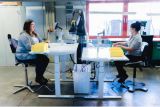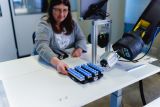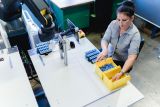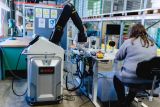Robotics for people with disabilities

Robots are well on the way to becoming ubiquitous in manufacturing, where they are having an impact on the work environment and on jobs themselves. But what does this new world of work look like? How does it divide work up between humans and machines? And how might robots help create attractive jobs for people with disabilities so they can be participate in the workforce? AQUIAS, a project conducted by Robert Bosch GmbH, the Fraunhofer Institutes for Industrial Engineering IAO and for Manufacturing Engineering and Automation IPA, and ISAK GmbH offers some answers. The project’s name is derived from its full title in German: work quality through tailored work-sharing between service robots and manufacturing workers with or without severe disabilities. It is funded by the German Federal Ministry of Education and Research (BMBF).
Wolfgang Pomrehn, product manager for APAS assistance systems at Bosch: “ In the AQUIAS project, we want to learn from severely disabled workers how to improve human-machine interactions. ”
Making work more attractive
The initiators of AQUIAS are taking a remarkable approach: they have deployed APAS, Bosch’s automated production assistant, at ISAK GmbH – a company that employs people with a variety of severe disabilities, some of whom have an extremely limited capacity for work. APAS is used in the assembly process for sanitary fixtures. Previously, a worker had to operate a hand-lever press up to 8,000 times a day to press intricate parts together, but now the robot has taken on this monotonous and physically demanding task. This eases the burden on workers and lets them focus on the final quality control.
One outcome of this project has been to improve the quality of work: with strenuous tasks falling away, there is more space for higher-quality tasks and for direct person-to-person communication. “What we’ve done is to have robots take on only those tasks that are physically demanding for people. All other work tasks, such as work-step preparation or quality control, are still performed by people, which ensures that their jobs are full of variety,” says David Kremer of the Fraunhofer Institute for Industrial Engineering IAO, who is coordinating the project. This gives disabled people job prospects and the opportunity to participate in modern manufacturing.
Tailoring robotics solutions to individual needs
To enable ISAK GmbH to implement this pioneering robotics technology, Bosch adjusted the workplace to suit the manufacturing environment and the various needs of the workforce. This called for a reconfiguration of the interfaces between humans and machines. Now the robot can flexibly adjust to different table heights and the sensor skin means there is no need for a safety barrier: if a worker comes too close, APAS automatically stops without any contact at all. This makes it possible to safely hand over workpieces and avoid collisions.
Learning from severely disabled workers
“In the AQUIAS project, we want to learn from severely disabled workers how to improve human-machine interactions. A production assistant needs to meet a wide variety of requirements that are often different than the norm. That’s why we develop tailored solutions and are constantly expanding the spectrum of situations and tasks that APAS can support,” says Wolfgang Pomrehn, product manager for APAS assistance systems at Bosch. Bosch takes the project results and derives measures from them for further improving the deployment of robots in production and logistics. The company plans to set up workplaces in its Blaichach (Allgäu) plant for workers with and without disabilities. There the focus will be on how to handle heavy aluminum blocks for automotive manufacturing that need to be moved around under the microscope for quality inspections.
Source of information
Robert Bosch GmbH & Profibusiness.world
Date
September 27, 2018





